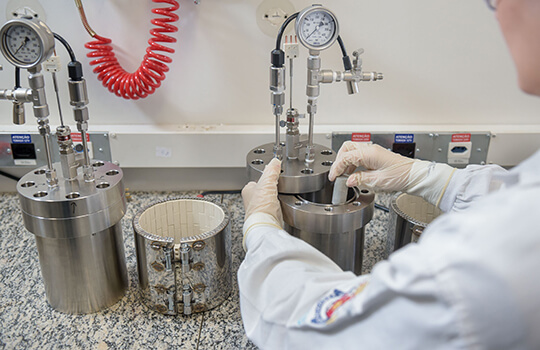The initiative is related to safety in carbon dioxide storage
A Petrobras-funded project by the Institute of Petroleum and Natural Resources (IPR) has been successfully looking for cement additives in the construction of oil wells. The goal is to use materials with higher chemical resistance in environments rich in carbon dioxide (CO2), such as those found in oil field wells. The group came up with formulas using polymers and mineral fillers. Laboratory results were very promising so much so that researchers are working on the second phase of the investigation, having received twice as much funding as was expected in the beginning in 2015. To date, 100 different experiments have been carried out including over 20 compounds. The second phase is supposed to last for another two and a half years.
Carbon dioxide is produced during various industrial activities, such as exploration and production of hydrocarbons (oils and gas). As an alternative to reducing CO2 emissions into the atmosphere, geological storage has been a good option to minimize the environmental impacts associated with climate change. “In the presence of water, CO2 at high concentrations corrodes the steel that covers the well and degrades the cement used to produce insulation between geological formations and steel. Both materials are used in the structure of the wells used for hydrocarbon production and also for geological storage of CO2,” Felipe Dalla Vecchia, IPR director, says. He currently serves as project coordinator and professor at the School of Technology.
In this context, researchers suggested the research and development of materials that ensure the functionality and safety of the oil / gas extraction and CO2 reinjection processes. The project was started in the Chemistry program, under the leadership of Professor Dr Sandra Einloft, Dean of the School of Technology.
 In this second stage, new equipment will be bought to reproduce the pre-salt layer to show the behavior of additives. In that environment, reservoirs may be more than 7,000 meters deep. A reactor, for example, was made upon demand for the Institute. “We started doing long-term testing on the three best-performing materials to see how this behavior projects over time because when we talk about CO2 storage we are talking about hundreds of years,” Dalla Vecchia says.
In this second stage, new equipment will be bought to reproduce the pre-salt layer to show the behavior of additives. In that environment, reservoirs may be more than 7,000 meters deep. A reactor, for example, was made upon demand for the Institute. “We started doing long-term testing on the three best-performing materials to see how this behavior projects over time because when we talk about CO2 storage we are talking about hundreds of years,” Dalla Vecchia says.
New components will now be evaluated. The group will also assess its use as an alternative for the recovery of old or leaky wells, in an effort to cover them with cement.
To date, the project has resulted in the publication of three articles in international journals. Professor Dr Marta Schütz, from the School of Technology and IPR, highlights the importance of the work: “We can even find modified cements with polymeric materials, but the temperature and pressure will be much milder. What we see in the case of CO2 storage is a totally different situation.” The temperature of environment reaches 65ºC, with pressures up to 300 bar (kgf / cm2 – kilogram-force per square centimeter). “We meet real specifications,” Dalla Vecchia adds.
To evaluate the application of the study, IPR researcher Victor Hugo dos Santos will spend a week in Rio de Janeiro, at the Petrobras Research Center, conducting tests with the new formulations developed. The company wants to see the validity of the incorporation of these additives into other physical properties of cement, especially before it is hardened. “Since phase I of the project, we have been concerned about using commercial materials to advance practical applications. We have tested out simpler methods. Some cement comes with additives from the company, ” the director of IPR says. “We are thinking of ways to keep the process unchanged in practice and keep the cost down”, Marta explains.
The project embraces a wide range of individuals, including undergraduate students to postdoctoral researchers. Most of them are associated with the School of Technology and the Graduate Program in Engineering and Materials Technology.